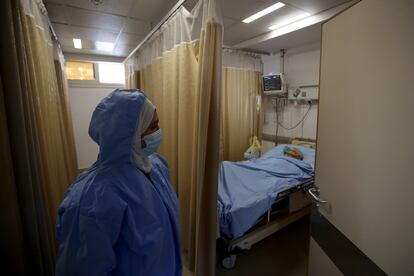How Egypt has eradicated a devastating hepatitis C epidemic and is now helping the rest of Africa
A decade ago, the country suffered from the world’s highest rates of the disease, but an unprecedented health campaign has made it the first nation on track to beat the epidemic, according to the WHO. Now it wants the rest of the continent to be able to follow in its footsteps

In early October, the World Health Organization (WHO) made an announcement that Cairo could only have dreamed of a few years ago. It confirmed that Egypt, following an unparalleled national campaign against hepatitis C, has become the first country in the world that is on track to end the epidemic by 2030.
The achievement is all the more remarkable given the fact that, just a decade ago, Egypt was the country with the highest rates of hepatitis C in the world. But between 2014 and 2020, it embarked on one of its largest-ever health campaigns, aimed at wiping the disease off the map. It mobilized tens of thousands of its healthcare workforce, screened 50 million people and treated more than 4 million. Now, with success assured, lessons learned and recognition from the global health community, Cairo has decided to go one step further and is helping other low- and middle-income countries, especially in Africa, to replicate its program.
“Egypt’s journey, from having one of the world’s highest rates of hepatitis C infection to being on the path to elimination in less than 10 years, is nothing short of astounding,” WHO director general Tedros Adhanom Ghebreyesus said in October. “Egypt is an example to the world of what can be achieved with modern tools, and political commitment at the highest level to use those tools to prevent infections and save lives,” he added. “Egypt’s success must give all of us hope and motivation to eliminate hepatitis C everywhere.”
An infected country
The origin of Egypt’s hepatitis C epidemic lies in a health campaign that was designed to treat an earlier epidemic. Between the 1940s and 1970s, the country had to contend, especially in rural areas, with a disease caused by coming into contact with parasitic worms that inhabited the infested waters of the Nile, says Imam Waked, professor from the department of hepatology at Egypt’s National Liver Institute.
“Every family in Egypt has [on average] at least one member who is infected with hepatitis C.”Mohamed El-Kassas, professor and head of endemic medicine at Cairo’s Helwan University
The only treatment that existed at that time for the disease were intravenous injections. But Waked says that hepatitis was as-yet unknown, and disposable syringes were not available. So, when the government began to promote a national campaign to fight the disease, beginning in the 1950s, it inadvertently spread the hepatitis C virus. To treat groups of between 500 and 600 young people, who were the target disease’s primary victims, 15 to 20 syringes could be used, the expert explains. “That’s the age group that spread hepatitis C. We created a large population that had the virus, which then spread even further through blood transfusions, in health clinics, and through more injections,” says the professor.
By the beginning of the 2000s, the Nile disease was practically eradicated. But in 2008, a demographics and public health survey found that 15% of Egyptians had hepatitis C antibodies, which indicated that they had been in contact with the virus, and that 10% of people between the ages of 15 and 59 were living with chronic infection. Seven years later, in 2015, another study detected its presence among 7% of adults. But this decline was due to the fact that hepatitis C was more common among older age groups — who had been treated for schistosomiasis decades earlier — than among the young, a factor which diluted the percentage of people affected by hepatitis C, but that did not indicate that the total number of cases had fallen.
“For many years Egypt was singled out as the country with the highest rates of hepatitis C worldwide,” says Mohamed El-Kassas, professor and head of endemic medicine at Cairo’s Helwan University. “Every family in Egypt has [on average] at least one member who is infected with hepatitis C,” he continues.
The consequences for the country were equally painful: in 2015, hepatitis C caused the loss of some 40,000 lives, which amounted to 7.6% of the country’s total deaths, and was responsible for a decrease in life expectancy by around 1.8 years in men and one year in women. It also caused a decline in the national GDP of 1.5% per year, or about $5 billion per year, according to World Bank estimates.
Faced with this challenge, Egypt set up a national hepatitis C control committee in 2006, and two years later launched its first national campaign aimed at widening access to treatment. The obstacles, however, were significant. Hepatitis C treatment was very expensive, it had severe side effects, few people were ultimately cured, and the treatment could not be offered to people with advanced liver disease. “It was not a very good treatment. We treated 50,000 patients a year and cured 15,000 to 20,000,” Waked remembers. “It was a huge burden on our health and the economy.”
A mobilized nation
The turning point came at the end of 2013, when hepatitis C treatment was revolutionized with a new orally administered antiviral drug that, when paired with other antivirals, raised the rate of recovery to more than 90% and almost completely eliminated side effects. The price of $84,000 per treatment set by Gilead, the pharmaceutical company that patented the drug, then became the main hurdle. But Egypt forced the company to negotiate that price after rejecting Gilead’s proprietary license. Negotiations managed to lower the price to $900 per case, and then by licensing the drug to local pharma companies, Egypt brought the cost down to less than $84. That constituted a 99.9% price drop, according to a 2021 study.
With the new pharmaceutical, everyone who had been treated in the past, but who had not been cured, restarted the process. By 2017, almost all Egyptians who knew they were living with hepatitis C (some 2.3 million people) had been treated, says Waked. Still, health authorities knew that there were between 2 and 3 million people living with the illness who had yet to be diagnosed. This was the point when, at the end of 2018, Cairo switched to a vastly more ambitious strategy, shifting its focus from controlling hepatitis C to eliminating the disease. The 100 Million Healthy Lives campaign aimed to test more than 60 million people and offer free treatment to those living with the virus. Most of its funding came from state coffers, supplemented by a loan of some $250 million from the World Bank.
One of the most important aspects of the campaign was its speed. The state opened nearly 16,000 testing sites across the country, including 1,000 mobile units that were accessible to walk-ins. Results were usually available within 20 minutes and those who tested positive were sent to another site for a confirmation test. Within seven days, those who were confirmed positive were directed to a center for treatment, which lasted 12 weeks, after which they were summoned back to a testing site to check their status.
Another one of the main factors behind the campaign’s success was a strong political will to address the epidemic, including that of the country’s president, Abdel Fattah el-Sisi. The government also unfurled a vast promotional and awareness-raising campaign via media platforms, social networks, text messages and at the grassroots level. And it was equally important that it could draw on the country’s existing, neglected but extensive, healthcare infrastructure. “It became a national priority for everyone: government, civil society, industry,” says John Ward, director of the Coalition for Global Hepatitis Elimination. “There was a real commitment to health equity: all Egyptians were to benefit from the program.”
By the end of the campaign, around 50 million Egyptians had been tested. Of these, 2.2 million were positive and did a confirmation test, which verified the positive status of 1.6 million. In total, 900,000 cases were treated, and another 700,000 more after the conclusion of the campaign. The rate of recovery was 98%. Then, the campaign was extended to minors. Between May 2019 and January 2020, 3.8 million students were tested, according to the health agency’s former spokesperson, Khaled Megahed.
“Thanks to the campaign the rate [of hepatitis C] has gone from 10% to 0.3% or 0.4%. That is an incredible achievement,” says Ward. “It’s one of the greatest achievements in global public health, at least in this century,” he adds.
And now, Africa
The success of Egypt’s campaign, and the experience it gained along the way, have become important assets that WHO believes can be employed by other low- and middle-income countries to develop their own plans to eliminate hepatitis C. Globally, around 75% of people living with the disease are located in these two categories of countries, according to the health organization.
In Africa, the situation is significantly different to that of Egypt in its most difficult moments, because hepatitis C is much less prevalent. Even in the countries that struggle most with the virus, such as the Democratic Republic of the Congo and Nigeria, rates range from 3% to 4%, according to Waked.
Due in part to the achievability of the goal, the then-Egyptian health minister Hala Zayed announced at an African hepatitis summit in 2019 that Cairo, which at the time was the chair of the African Union (AU), was prepared to offer countries throughout the rest of the continent technical support, expertise and free treatment for hepatitis C. It set an initial goal of reaching 1 million individuals. “When we discovered that hepatitis C was easy to cure and that the drug in Egypt was very cheap, we decided to help African countries in need of treatment by providing technical expertise, technology, counseling and free drugs,” says Waked.
“It is quite commendable that Egypt is extending health diplomacy to these countries,” says Ward. One of the first nations to benefit has been Ghana, where a 2021 survey found that the rate of hepatitis C in a sample of 100,000 people was 2.6%, with significantly higher rates in its northern regions.
In March 2023, Egypt sent Ghana the first donation of drugs to treat the disease, with an initial goal to make them available to people who have been diagnosed, but who have not been able to access treatment due to cost. Currently, patients still must pay for their own tests to determine their viral load, which cost between $37 and $80. “A cheaper price, or alternative tests, would improve our capacity enormously,” says Waked.
Speaking to the same point, Ward points out that it’s not enough to just give out free drugs. “You have to get the other parts of [Egypt’s] program in place for those drugs to be used. And that’s where technical assistance comes into play, choosing the right partners in each country and then giving them the free drugs,” he says.
In addition to Ghana, the Egyptian minister of health says that at the start of 2020, a little more than 30,500 citizens in South Sudan, Chad and Eritrea had received hepatitis C tests and that around 400 had received free treatment. Waked says that Egyptian health authorities are also in contact with The Gambia. And Ward believes that Kenya, Tanzania, Uganda, Sierra Leone, Zambia and, to some extent, South Africa, could benefit from similar assistance.
Sign up for our weekly newsletter to get more English-language news coverage from EL PAÍS USA Edition
Tu suscripción se está usando en otro dispositivo
¿Quieres añadir otro usuario a tu suscripción?
Si continúas leyendo en este dispositivo, no se podrá leer en el otro.
FlechaTu suscripción se está usando en otro dispositivo y solo puedes acceder a EL PAÍS desde un dispositivo a la vez.
Si quieres compartir tu cuenta, cambia tu suscripción a la modalidad Premium, así podrás añadir otro usuario. Cada uno accederá con su propia cuenta de email, lo que os permitirá personalizar vuestra experiencia en EL PAÍS.
¿Tienes una suscripción de empresa? Accede aquí para contratar más cuentas.
En el caso de no saber quién está usando tu cuenta, te recomendamos cambiar tu contraseña aquí.
Si decides continuar compartiendo tu cuenta, este mensaje se mostrará en tu dispositivo y en el de la otra persona que está usando tu cuenta de forma indefinida, afectando a tu experiencia de lectura. Puedes consultar aquí los términos y condiciones de la suscripción digital.
More information
Archived In
Últimas noticias
Most viewed
- Reinhard Genzel, Nobel laureate in physics: ‘One-minute videos will never give you the truth’
- Oona Chaplin: ‘I told James Cameron that I was living in a treehouse and starting a permaculture project with a friend’
- Pablo Escobar’s hippos: A serious environmental problem, 40 years on
- Chevy Chase, the beloved comedian who was a monster off camera: ‘Not everyone hated him, just the people who’ve worked with him’
- Why we lost the habit of sleeping in two segments and how that changed our sense of time











































